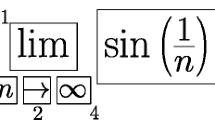Abstract
There are many studies on the role of images in understanding the concept of limit. However, relatively few studies have been conducted on how students’ understanding of the rigorous definition of limit is influenced by the images of limit that the students have constructed through their previous learning. This study explored how calculus students’ images of the limit of a sequence influence their understanding of definitions of the limit of a sequence. In a series of task-based interviews, students evaluated the propriety of statements describing the convergence of sequences through a specially designed hands-on activity, called the ɛ–strip activity. This paper illustrates how these students’ understanding of definitions of the limit of a sequence was influenced by their images of limits as asymptotes, cluster points, or true limit points. The implications of this study for teaching and learning the concept of limit, as well as on research in mathematics education, are also discussed.



Similar content being viewed by others
References
Alcock, L., & Simpson, A. (2004). Convergence of sequences and series: Interactions between visual reasoning and the learner’s beliefs about their own role. Educational Studies in Mathematics, 57, 1–32.
Alcock, L., & Simpson, A. (2005). Convergence of sequences and series 2: Interactions between visual reasoning and the learner’s beliefs about their own role. Educational Studies in Mathematics, 58, 77–100.
Apostol, T. (1974). Mathematical analysis. Reading, MA: Addison-Wesley.
Bezuidenhout, J. (2001). Limits and continuity: Some conceptions of first-year students. International Journal of Mathematical Education in Science and Technology, 32, 487–500.
Brackett, J. D. (1991). The association of mathematical context with students’ responses to tasks involving infinity. Dissertation, University of Georgia.
Brousseau, G. (1997). Theory of didactical situations in mathematics (N. Balacheff, M. Cooper, R. Sutherland, & V. Warfield, Trans.) Dordrecht, The Netherlands: Kluwer Academic.
Cornu, B. (1991). Limits. In D. Tall (Ed.), Advanced mathematical thinking (pp. 153–166). Dordrecht, The Netherlands: Kluwer Academic.
Cottrill, J., Dubinsky, E., Nichols, D., Schwingendorf, K., Thomas, K., & Vidakovic, D. (1996). Understanding the limit concept: Beginning with a coordinated process schema. Journal of Mathematical Behavior, 15, 167–192.
Davis, R. B., & Vinner, S. (1986). The notion of limit: Some seemingly unavoidable misconception stages. Journal of Mathematical Behavior, 5, 281–303.
Ferrini-Mundy, J., & Lauten, D. (1993). Teaching and learning calculus. In P. S. Wilson (Ed.), Research ideas for the classroom: High school mathematics (pp. 155–176). New York: Macmillan.
Fischbein, E. (1987). Intuition in science and mathematics. Dordrecht, The Netherlands: D. Reidel.
Hitt, F., & Lara-Chavez, H. (1999). Limits, continuity and discontinuity of functions from two points of view: That of the teacher and that of the student. In L. Bills (Ed.), Proceeding of the British Society for Research into Learning Mathematics, 19, 49–54.
Kawski, M. (1997). How CAS and visualization lead to a complete rethinking of an introduction to vector calculus. In W. Fraunholz (Ed.), Proceeding of the Third International Conference on Technology in Mathematics Teaching. Koblenz, Germany.
Kidron, I., & Zehavi, N. (2002). The role of animation in teaching the limit concept. The International Journal of Computer Algebra in Mathematics Education, 9, 205–227.
Mamona-Downs, J. (2001). Letting the intuitive bear on the formal: A didactical approach for the understanding of the limit of a sequence. Educational Studies in Mathematics, 48, 259–288.
Marsden, J. E., & Hoffman, M. J. (2000). Elementary classical analysis (2nd ed.). New York: Freeman.
Navarro, M., & Carreras, P. (2006). Constructing a concept image of convergence of sequences in the van Hiele framework. Research in Collegiate Mathematics Education, VI, 61–98.
Neuhauser, C. (2004). Calculus for biology and medicine (2nd ed.). Upper Saddle River, New Jersey: Pearson Education.
Oehrtman, M. (2002). Collapsing dimensions, physical limitation, and other student metaphors for limit concepts: An instrumentalist investigation into calculus students’ spontaneous reasoning. Dissertation, The University of Texas.
Piaget, J., & Inhelder, B. (1967). The child’s conception of space (F. J. Langdon & J. L. Lunzer., Trans.). New York: The Norton Library.
Pinto, M., & Tall, D. (2002). Building formal mathematics on visual imagery: A case study and a theory. For the Learning of Mathematics, 22, 2–10.
Przenioslo, M. (2004). Images of the limit of function formed in the course of mathematical studies at the university. Educational Studies in Mathematics, 55, 103–132.
Roh, K. (2005). College students’ intuitive understanding of the limit of a sequence and their levels of reverse thinking. Dissertation, The Ohio State University.
Sierpińska, A. (1987). Humanities students and epistemological obstacles related to limits. Educational Studies in Mathematics, 18, 371–397.
Stewart, J. (2003). Calculus: Early transcendental single variable (5th ed.). Belmont, CA: Brooks/Cole-Thomas Learning.
Stroyan, K. D. (1998). Mathematical background: Foundations of infinitesimal calculus. Retrieved from http://www.math.uiowa.edu/~stroyan/research.htm. (June 8, 2007)
Szydlik, J. E. (2000). Mathematical beliefs and conceptual understanding of the limit of function. Journal for Research in Mathematics Education, 31, 256–276.
Taback, S. (1975). The child’s concept of limit. In M. F. Rosskopf (Ed.), Children’s mathematical concepts (pp. 111–144). New York: Teachers College Press.
Tall, D. (1992). The transition to advanced mathematical thinking: functions, limits, infinity, and proof. In D. A. Grouws (Ed.), Handbook of research on mathematics teaching and learning (pp. 495–511). New York: Macmillan.
Tall, D., & Vinner, S. (1981). Concept image and concept definition in mathematics, with particular reference to limits and continuity. Educational Studies in Mathematics, 12, 151–169.
Vinner, S. (1991). The role of definitions in the teaching and learning of mathematics. In D. Tall (Ed.), Advanced mathematical thinking (pp. 65–81). Dordrecht, The Netherlands: Kluwer Academic.
Williams, S. (1991). Models of limit held by college calculus students. Journal for Research in Mathematics Education, 22, 219–236.
Acknowledgement
The author thanks Professor Sigrid Wagner, Professor Alfinio Flores, and three anonymous reviewers for their helpful comments on earlier versions of the article.
Author information
Authors and Affiliations
Corresponding author
Rights and permissions
About this article
Cite this article
Roh, K.H. Students’ images and their understanding of definitions of the limit of a sequence. Educ Stud Math 69, 217–233 (2008). https://doi.org/10.1007/s10649-008-9128-2
Received:
Accepted:
Published:
Issue Date:
DOI: https://doi.org/10.1007/s10649-008-9128-2




